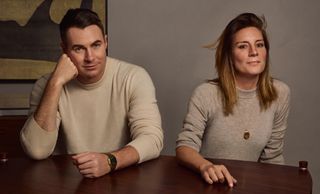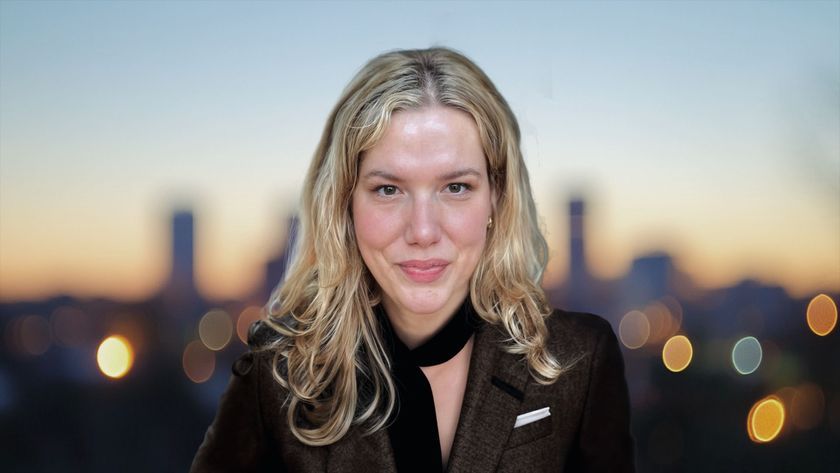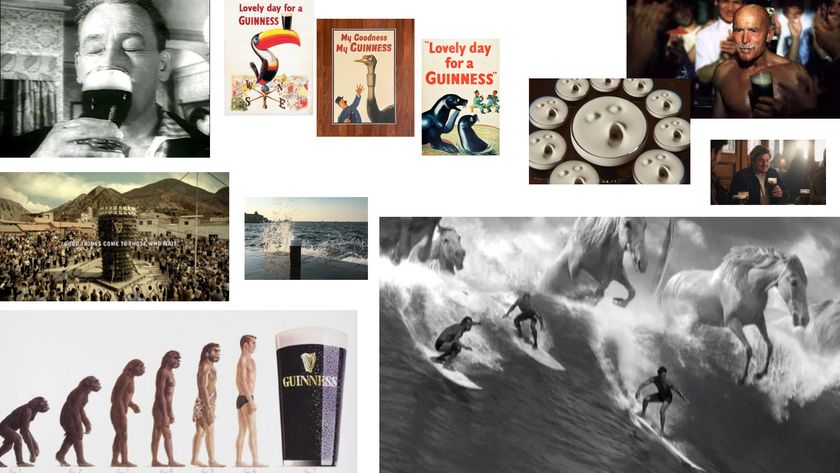"I’d love to see fewer boundaries in the design industry”: a day in the life of Amy Globus
Team's co-founder discusses creating with an artist's sensibility and the importance of trusting your instincts.

Amy Globus is the co-founder of Team – the Brooklyn-based design studio behind the groundbreaking Pfizer rebrand. Grounded by a focus on "clarity, meaning, and emotion," Team has gone on to shape some iconic East Coast Institutions, from Independent Art Fair to The Bronx Museum. As an exhibited artist Amy is deeply rooted in the art world, approaching her work with a unique artist's sensibility.
As a board member of the Rema Hort Mann Foundation, Amy's connection to the art world is a relationship of symbiosis, giving back to the community after experiencing the foundation's generosity firsthand. As part of our Day in the Life series, I caught up with Amy to discuss how her art career has informed her role at Team, the state of inclusivity in the industry, and the importance of trusting your instincts.

Could you walk me through a typical day in your role?
My days are fast-paced. All of the projects that Team works on, everything that I experience – from family breakfasts to taking my kids to school to the books I read –intertwine and inform my creative process. When I’m in the office, I’m usually on calls with clients tackling the unique challenges that come with each project and finding solutions that fit. I spend a lot of time with our designers, strategists, and project managers making sure that our strategy, design, and overall creative visions are aligned. We laugh a lot too.
What was your early career like?
I began my career as a visual artist, working with everything from crystals to sound mixing – I even raised an octopus. From the start, I knew that I wanted to explore what it means to be human. My love of learning drove me to try any and everything that sparked my curiosity. It wasn’t until I started working in design that I realized just how much creative freedom I’d had as an artist. At an agency, there’s often little room for mistakes or time to experiment and try new things. When things move fast, you have to keep up.
I learned a lot in my time as a designer, but I missed the sense of exploration and imagination that I had as an artist. I loved the ability to experiment with mediums and learn how to make any idea a reality. That’s when the idea of starting my own studio with my co-founder John Clark took shape. We knew we wanted to do things differently. We wanted to be able to work at pace while still creating space for all of the reimagining and experimentation to make something refreshing, new, and expansive — to make the best possible work.

What inspires your personal art?
Everything – nature and human nature. I’m fascinated by the ways we interact with our environment, how it shapes us, and how we shape it in return. Whether it’s the vastness of a landscape or the intricacies of human relationships, I’m always curious about the connections we create with the world, both natural and constructed. There’s a deep mystery and beauty in nature that speaks to me, especially in how it intersects with our emotions, memories, and sense of identity. My work is often about exploring these layers, about finding the spaces where the external world mirrors our inner lives.
How has your art career informed your role as creative director at Team?
I find that my career as a visual artist always seeps through the cracks of everything I do. I’ve always been drawn to the idea of cross-pollination, so whether it’s making honey, reading books to my kids, watching movies, going to art shows, or teaching myself about business – all ends up in the work I do at Team.
John and I often talk about how we can take inspiration from all different types of expertise and apply it across our projects. It’s surprising how many connections you can find between clients, no matter how different their industries are. Startups, artists, Fortune 500s, cultural institutions, thought leaders, etc. – they all have something valuable to offer each other.

How do you approach design with an artistic lens?
Though it might not be the first thing that comes to mind, I think the key to approaching design with an artist’s sensibility is through strategy. Strategy is crucial. A big part of my process is holding up a mirror to our clients and asking, “Does this work authentically represent your aspirations? Is it true to who you are?”
I really value intentionality in this way. To approach design artistically is to trust your intuition. Strategy helps us get there. It’s about asking, “What is this work saying? What are we trying to communicate, and does it reflect us authentically?” At their core, strategy and design work together to understand where clients are and where they want to go. The rest is about bridging that gap.

Tell me about a tricky work-related challenge and how you approached it
We’re working on a new rebrand project that has been really challenging – but also really rewarding. The client had their own preferred ways of working that didn’t align with our typical approach, so it was a great experience in figuring out how to listen, learn, and connect with a client who thought about things very differently than how we’re used to. In the end, the collaboration was really fruitful – the client pushed us and we pushed them, and the end result is stronger, more interesting, and more authentic than if we had done it the “typical” way.
Could you tell me more about Team’s rebrand for Pfizer?
The Pfizer project came at a crucial time – right at the peak of the pandemic. Things had to move insanely fast. It was a last-minute pitch and we were over 300 other logos up for review. It was a significant moment for Pfizer so we knew that it would be the most important creative work of our careers. Given the constraints of lockdown, our team really had to work creatively and find new ways to ideate, invent, and collaborate. I’m incredibly proud of my team for the immense effort and commitment they gave to this project.
The result was a rebrand that not only honored Pfizer’s legacy but also symbolized its future – a story of progress, innovation, and resilience in the face of the impossible.
It was an involved process with intensive quantitative and qualitative testing, including interviewing a team of Pfizer scientists that knew first-hand about the impact of the organization. Talking to them and hearing their personal connection and ties to the work they were doing, even at the most uncertain times, really inspired us to work hard and create something that reflected their passion. We did numerous brand explorations and the one that made it was an idea that actually started from one of the scientists we met, who said that we were all connected by one thing: DNA, the very essence of life.
The DNA helix became this unifying symbol for the Pfizer rebrand. It symbolized not only Pfizer’s long history as a pioneer but also its future – this vision of progress and innovation. We wanted this rebrand to truly signify this monumental transformation and capture this unmoveable purpose that we saw in every Pfizer scientist and colleague that we met – to do the impossible and make disease a thing of the past.
And our relationship with Pfizer has strengthened since then, with the launch of Pfizer's new employer brand this month. We worked closely with Pfizer Careers to develop “Use your power for purpose,” a new EVP that champions Pfizer’s purpose and celebrates their global talent community.

Which project are you most proud of and why?
I’m most proud of our work with Pfizer. It captures a story of resilience – losing, listening, coming back stronger. It wasn’t just about creating a new logo or a brand refresh; it was about understanding the weight of the moment. In the middle of a global crisis, when everything was uncertain, we had to dig deep, adapt quickly, and find ways to connect with what Pfizer was experiencing.
There were moments where we had to step back, listen carefully to the team of scientists, and understand the challenges they were facing. That process made our work stronger and more meaningful. The result was a rebrand that not only honored Pfizer’s legacy but also symbolized its future – a story of progress, innovation, and resilience in the face of the impossible.
How inclusive is the design industry in 2024?
I think that the design industry is making progress toward inclusivity, but there’s still a lot of work to be done. We’re seeing more conversations around diversity and representation, and that’s a positive step. But inclusivity needs to be built into the entire process – from who’s at the table, to the voices we elevate, to the stories we choose to tell. It’s not just about checking a box; it’s about creating space for a wide range of perspectives and making sure those perspectives actually shape the work.
At Team, we’ve always believed that the best ideas come from a diversity of experiences, and we’re constantly looking for ways to make our environment more inclusive – whether that’s through the talent we hire, the clients we partner with, or the creative work we produce. Inclusivity isn’t just a goal; it’s the foundation for innovative and impactful design.

What do you think the design industry needs to improve?
I’d love to see fewer boundaries in the design industry – between mediums, practices, and, most importantly, between each other. Collaboration is essential to great creative work. There’s so much value in exchanging ideas with people who have completely different perspectives from you, or finding inspiration in unlikely places. But the nature of business tends to be competitive.
Yes, we’re often “competing” for projects, but imagine how powerful it would be if my team and another team could tackle a challenge together. What type of new ideas would we bring or would they bring? Or what ideas would come from just putting us in a room together? We always say that design should be fun. Not just the end result but the process itself should be enjoyable. I’d love to build more community in our industry and open up our spaces to the abundance of talent that’s out there.

Could you tell me about your involvement with the Rema Hort Mann Foundation?
The Rema Hort Mann Foundation is incredibly meaningful to me. They were one of my first supporters when I was named a grantee back in 2002. At that point in my career, I was just starting out so to receive an award like that was huge for me. It was recognition for my work and my vision. Now, the program is legendary – my name is listed alongside friends and artists I admire.
Fast forward 22 years, and I’m honoured to serve as a board member. I’m deeply proud of my relationship with RHMF. They do such important work nurturing emerging artists and providing direct support to cancer patients. Having experienced their generosity firsthand, I’m thrilled to give back, not only as a board member but also as a creative partner (rebrand in the works with Team – stay tuned!).

What are your favourite tools?
My favorite tools are the things that inspire me – books like Klara and the Sun by Ishiguro, or The Ones Who Walk Away from Omelas by Ursula Le Guin, art exhibitions, travel, and learning new crafts or skills. Inspiration is my best tool; it fuels everything I do. It’s those unexpected moments – seeing a new place, reading a passage that sticks with me, or trying my hand at something new – that spark ideas and open up creative possibilities. Software and technology evolve constantly, but inspiration stays with you, shaping the way you think and create in a lasting way.

What’s your dream project/dream client?
I’d love to rebrand Architectural Digest (AD). It’s one of my favorite publications, and as a long-time subscriber and interior design fanatic, I feel it’s about time for a fresh design direction. AD has such a rich history and a strong voice in the design world, but there’s so much opportunity to bring a new perspective forward, one that reflects the evolving world of architecture, design, and culture. A rebrand would be an exciting chance to honor that legacy while pushing the boundaries of what the magazine can represent moving forward.

What career advice would you give your younger self?
I would tell my younger self to stay connected – with others, with yourself, and with the things that inspire you. When you’re starting out, whether it’s in a new project or building a business, it’s easy to feel out of place and doubt yourself. But it’s important to recognize the value of your skills and experience and trust that you can handle what comes your way.
I’d also remind her to own her accomplishments. As women, we’re often encouraged to be modest and share the spotlight, and while giving credit is important, it’s equally okay to be proud of your work and to voice that pride.
Finally, I’d tell her to never lose that sense of experimentation and curiosity. In design, you’ll come across systems and ways of working that seem rigid. But before you follow the established path just because "that’s how it’s always been done," remember to consider things from your own fresh, creative perspective. There’s never just one way to solve a problem. Trust your instincts.

Anything else to add?
I believe that exploration, taking risks, and being authentic are key to both personal growth and creative success. I encourage others, especially women, to own their accomplishments, trust their instincts, and approach challenges as chances to innovate. Throughout my career, I’ve seen firsthand how staying connected to what drives you makes all the difference. Confidence, curiosity, and collaboration are what help you thrive – not just in the creative industry, but in life.
Get the Creative Bloq Newsletter
Daily design news, reviews, how-tos and more, as picked by the editors.

Thank you for reading 5 articles this month* Join now for unlimited access
Enjoy your first month for just £1 / $1 / €1
*Read 5 free articles per month without a subscription

Join now for unlimited access
Try first month for just £1 / $1 / €1

Natalie Fear is Creative Bloq's staff writer. With an eye for trending topics and a passion for internet culture, she brings you the latest in art and design news. Natalie also runs Creative Bloq’s Day in the Life series, spotlighting diverse talent across the creative industries. Outside of work, she loves all things literature and music (although she’s partial to a spot of TikTok brain rot).

















